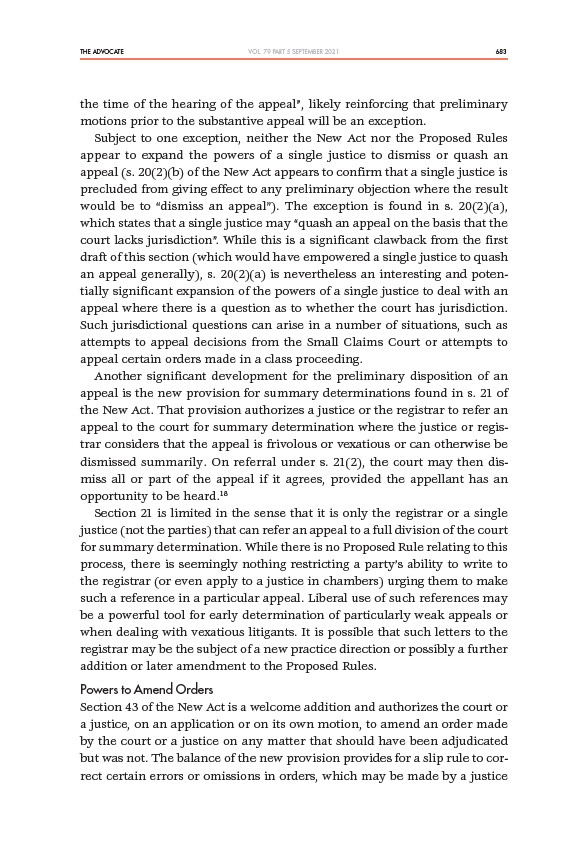
THE ADVOCATE 683
VOL. 79 PART 5 SEPTEMBER 2021
the time of the hearing of the appeal”, likely reinforcing that preliminary
motions prior to the substantive appeal will be an exception.
Subject to one exception, neither the New Act nor the Proposed Rules
appear to expand the powers of a single justice to dismiss or quash an
appeal (s. 20(2)(b) of the New Act appears to confirm that a single justice is
precluded from giving effect to any preliminary objection where the result
would be to “dismiss an appeal”). The exception is found in s. 20(2)(a),
which states that a single justice may “quash an appeal on the basis that the
court lacks jurisdiction”. While this is a significant clawback from the first
draft of this section (which would have empowered a single justice to quash
an appeal generally), s. 20(2)(a) is nevertheless an interesting and potentially
significant expansion of the powers of a single justice to deal with an
appeal where there is a question as to whether the court has jurisdiction.
Such jurisdictional questions can arise in a number of situations, such as
attempts to appeal decisions from the Small Claims Court or attempts to
appeal certain orders made in a class proceeding.
Another significant development for the preliminary disposition of an
appeal is the new provision for summary determinations found in s. 21 of
the New Act. That provision authorizes a justice or the registrar to refer an
appeal to the court for summary determination where the justice or registrar
considers that the appeal is frivolous or vexatious or can otherwise be
dismissed summarily. On referral under s. 21(2), the court may then dismiss
all or part of the appeal if it agrees, provided the appellant has an
opportunity to be heard.18
Section 21 is limited in the sense that it is only the registrar or a single
justice (not the parties) that can refer an appeal to a full division of the court
for summary determination. While there is no Proposed Rule relating to this
process, there is seemingly nothing restricting a party’s ability to write to
the registrar (or even apply to a justice in chambers) urging them to make
such a reference in a particular appeal. Liberal use of such references may
be a powerful tool for early determination of particularly weak appeals or
when dealing with vexatious litigants. It is possible that such letters to the
registrar may be the subject of a new practice direction or possibly a further
addition or later amendment to the Proposed Rules.
Powers to Amend Orders
Section 43 of the New Act is a welcome addition and authorizes the court or
a justice, on an application or on its own motion, to amend an order made
by the court or a justice on any matter that should have been adjudicated
but was not. The balance of the new provision provides for a slip rule to correct
certain errors or omissions in orders, which may be made by a justice